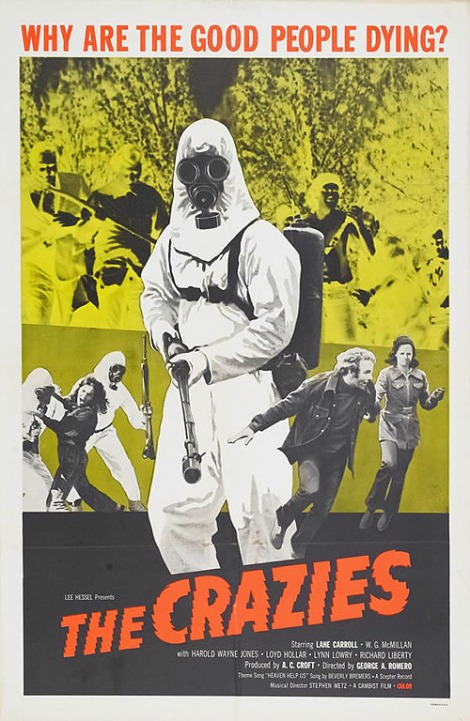In 1969, George A Romero and Image Ten Productions revolutionised the horror genre with the reinvention of a classic movie monster. Following the eventual success of their indie film, Romero endeavoured to continue to make other small independent films of various genres, though in 1972 he revisited horror in a slightly different manner. Zombies embody one side of social horror, though Romero made a film wherein the military and even one's next door neighbour was just as frightening. Unfortunately, it was also a critical and commercial flop that was even remade by Brett Ratner in 2010.

The Crazies is set in Evans City, a small town in rural Pennsylvania, and opens on two young children watching their enraged father tear up and then proceed to burn down the family home while they and their recently murdered mother are trapped inside. Local firemen David and Clanker arrive with their retinue to subdue the blaze and they see the father handcuffed in the back of a police car, still muttering and mad. David and Clanker are both Vietnam veterans, though David served in the Special Forces Green Berets, and the two attempt to escape town with David's pregnant nurse wife Judy and a few other residents. Political and military leaders are concurrently arguing at how to contain the outbreak of a bio-chemical weapon after a military plane crashed near Evans City.The name of the chemical agent is Codename: Trixie and it drives the residents into a murdering frenzy, and so martial law is declared and a military force wearing white military hazmat suits invades and surrounds the town in an attempt to quarantine the effect of Trixie. Inevitably and violently, the infected residents fight back.
The Crazies is a not so much a war film in content, but in context. Vietnam was the first televised war, and took place right in the middle of two vital decades of social and cultural revolution in the West. But incidents such as the Kent State massacre, where the United States National Guard (a volunteer military force for deployment on US soil) shot at unarmed college students in Ohio, killing four, exacerbated matters domestically. Scenes such as this involved the first deployment of US troops against its own citizens and using deadly force in a century and had long-lasting cultural impact. The Crazies is one of the first films to depict the American military in combat against its own civilian population as a large body, as opposed to individual villains. In particular, one scene involving a shootout between the military and enraged citizens of Evans City on a grassy hill next to a small woody area is particularly comparable to footage from Vietnam, sans the woman sweeping the grass with a broom.

Additionally, the film contains several scenes of the military violently and carelessly raiding congregations of people in churches, dance halls and even in their homes. In a montage of these moments, the soldiers detain a family including their crying infant. These scenes are undeniably stressful and act as an early incarnation of the infamous "Ghetto Holocaust" scene at the beginning of Romero's classic Dawn of the Dead. Viewing it from 2014, these raids is repeated in real life time and again, but in scenes such as the infamous photo of Elian Gonzalez, it's particularly evident. It's this imagery, with the argumentative and eventually ineffectual nature of the government within the film that makes Romero's film so effective as a searing social commentary. And ultimately, the film leaves the viewer unable to distinguish just who the Crazies are, the military, the infected or both.
The Crazies is full of flaws in only the way that a film made in small-town Pennsylvania, on a budget of $275,000, and involving dozens of non-professional actors, including the leads, can be. But no-one does this kind of social horror like Romero, and each scene is underrated in its iconography. There are some awful sound issues, that may just be because of the time and the equipment, but nevertheless it creates an awful jumbled mess, that can and does work at times. And the less said about the acting, the better, though two of the actors appear in later Romero films (Richard Liberty as Artie in The Crazies and Doctor "Frankenstein" Logan in Day of the Dead, and Richard France as Doctor Watts and Doctor Rausch, respectively). This is a lost classic in the canon of Romero's films, though it certainly is rough going. But it is very easy to see George Romero's talent and his limitations in making this film.


No comments:
Post a Comment